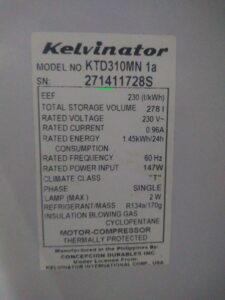The experience of buying a used refrigerator has a lot of similarities with purchasing second-hand cars; you’ll get a good deal if you know what to look for. On the flip side, you can easily end up with a lemon if you don’t have a clue on what to look for.
Here is a quick rundown of some of the questions to ask the seller so that you can gauge whether the deal is good or not:
- What is the model name?
- How old is the unit?
- How much is it vs. the original price?
- Is it still in good condition?
- How many times has it been repaired?
- What is its EEF (energy efficiency factor)?
- Is it still using R12 refrigerant?
- Is it 110V or 220V?
- How will you transport it?
In this article, we will better explain the factors to consider when buying a used refrigerator, and what to look for in a unit to help minimize the chance of you buying a lemon.
Know the make and model of the unit
Knowing the model name of the unit is important as you can use it to research the benchmark price of the model.
If you can physically inspect the item, check the refrigerator label located on the interior wall of the fridge. The brand and the model name can be seen from there.
You can also check the rating label at the lower back of the fridge, somewhere near the compressor.
Now that you know the model name, you should check its price from online sources or brochures. You should also ask around other people if they have good and bad experiences with that brand or model.
Determine the age of the unit
Now that you know the model name, you should also know the age of the unit. While you can give the seller the benefit of the doubt when he gives you the age of the fridge, you should also know when the model was manufactured to see whether the details checks out.
The best way to know when the unit was manufactured is through the serial number. Same as before, you can check the serial number (SN) on the refrigerator label inside the fridge.
Serial numbers often contain the year that that particular unit has been manufactured. Most manufacturers put it in the front of the string, while others put it somewhere near the front, as is the case with our refrigerator here that my family bought sometime in 2014:

From there, you should compare it against the average lifespan of refrigerators, which according to the National Association of Home Builders (NAHB) is 13 years.
With that, you should be aware of the risks of buying an older refrigerator. Buying a 10 year old refrigerator is certainly more affordable, you should temper your expectation of its remaining usable life. Using the benchmark as a guide, you should expect at least 3 more years of use for the unit. That is, of course, unless it has a breakdown early on. Calculate whether your investment is worth the risk and the hassle of repairing and replacing.
In the next section, we will show you a technique to estimate the ideal price range of a used refrigerator.
Price range
There is no hard and fast rule when it comes to pricing a used refrigerator, but we will try to give you at least a benchmark to compare against to see if the deal is good or not. For this, we will use the same concept used in calculating a car’s depreciation rate.
A good rule of thumb to follow is that the value of the fridge goes down by 15% the moment it leaves the appliance store. After that, the value goes down by 6.67%[1] of its original price every year. To illustrate this, we’ve created a table below, which assumes that you are buying a model with an original price of ₱19,998:
| Year | Rate | Price | vs. Original Price |
| – | – | ₱19,998.00 | 100% |
| 0 | 15.00% | ₱16,998.30 | 85% |
| 1 | 6.67% | ₱15,664.43 | 78% |
| 2 | 6.67% | ₱14,330.57 | 72% |
| 3 | 6.67% | ₱12,996.70 | 65% |
| 4 | 6.67% | ₱11,662.83 | 58% |
| 5 | 6.67% | ₱10,328.97 | 52% |
| 6 | 6.67% | ₱8,995.10 | 45% |
As you can see, the value of the refrigerator at the 5th or 6th year should be around half of what the original price was. Of course, this is only a benchmark. The value of the fridge can be further depreciated if it is in a particularly bad condition. We will discuss this in the next section.
Is it in good condition?
As they say: it’s not the years, it’s the mileage. Most of the time, the condition of the item is the deal breaker when it comes to a used refrigerator.
If you can, you should physically inspect the unit to make sure that it is in good condition. We’ve made a list of the commonly seen flaws in used refrigerators, and we’ve divided it into acceptable (working condition – can be repaired/you can probably haggle the price down further) and unacceptable (compromised performance – requires extensive repairs/no-go zone)
Acceptable
- Minor dents and scratches
- Stains
- Internal light not working (fixable)
- Loose gasket (fixable)
- Damaged or incomplete shelves (you can buy aftermarket parts)
Unacceptable
- Holes and corrosion
- Cooling problems
- Compressor issue
- Refrigerant leak
Service history
Always ask the seller if the refrigerator has been repaired at any point of its life or if they have been experiencing issues with it lately.
If the fridge has been repaired before, chances are it will experience the same issues as before in the future. Do not buy a used refrigerator that has been extensively repaired before as you will surely end up with a lemon.
Check its EEF and power consumption
The energy efficiency factor (EEF) tells you how efficiently a refrigerator uses its power to cool its rated storage volume.
A high EEF number means that that particular model is more energy-efficient, and therefore has a lower operating cost, while a low EEF means that the model is not efficient.
Older models tend to have low EEF and high power consumption values, as they are not equipped with the technological improvements made on newer models.
As we’ve written before, the average power consumption of refrigerators hover at 1.13 kWh per day. This means that if the power rate is at ₱9.744/kWh, then you should estimate that your refrigerator will contribute at least ₱330 per month to your electricity bill.
Meanwhile, the EEF of refrigerators are dependent on their size. We’ve also written about the average EEF per capacity of refrigerators before. Go check it out!
Check its refrigerant
Back in the day, the most common refrigerant gas was Freon (R-12). However, Freon is a CFC (chlorofluorocarbons) that damages the ozone layer. Freon has been phased out in lieu of more environment-friendly refrigerants because of this.
If the unit you’re planning to buy is still using R-12, it is (1) Jurassic and thus it may be long past its usable life, and (2) it is bad for the environment. Please choose another item.
Is it using 110V or 220V?
In the Philippines, the standard voltage is 220V at a frequency of 60Hz. However, some used refrigerators may come from other countries (like Japan surplus items) where the standard voltage is at 110V and a frequency of 50Hz.
Plugging in a 110V refrigerator in to a 220V socket is a recipe for disaster. Not only will it fry the electronics of your refrigerator, it can also cause an electrical fire.
While you can certainly make the refrigerator work by plugging it in to a transformer, keep in mind that this is another cost on your part.
How will you transport it?
Now that you’ve decided to buy the used refrigerator, it’s now time to transport it to your house. Refrigerators are typically transported upright, but due to certain circumstances, there may be no other choice but to lay a refrigerator on its side during transport. However, doing this will affect the compressor negatively, especially if you do not
When laid sideways, the thick and viscous compressor oil can run off to the cooling coils, thus clogging them up. This prevents the refrigerant gas from flowing through them and thus your refrigerator won’t cool.
With that said though, it is generally safe to lay a refrigerator on its side provided that you let it rest upright before turning it on. This will allow the oils to flow back down to the compressor.
A good rule of thumb to follow is to let the refrigerator rest upright (and unplugged) for the same amount of time that it was lying on its side. If you laid it on its side for 4 hours, then you should let it rest upright for 4 hours as well.
Also take into account that the item no longer has a box. So try to secure and protect it as much as you can.
Conclusion
We hope that the information we’ve given was helpful in your search for a used refrigerator. Always keep this pointers in mind to avoid bad deals and lemons.

Miguel Mores worked for 5 years as a member of the product management team for a home appliance company in the Philippines. He started 101appliance to answer the most common customer questions that he has encountered during his time in the industry. He now works in the digital marketing field and manages a small online bookstore on the side.

